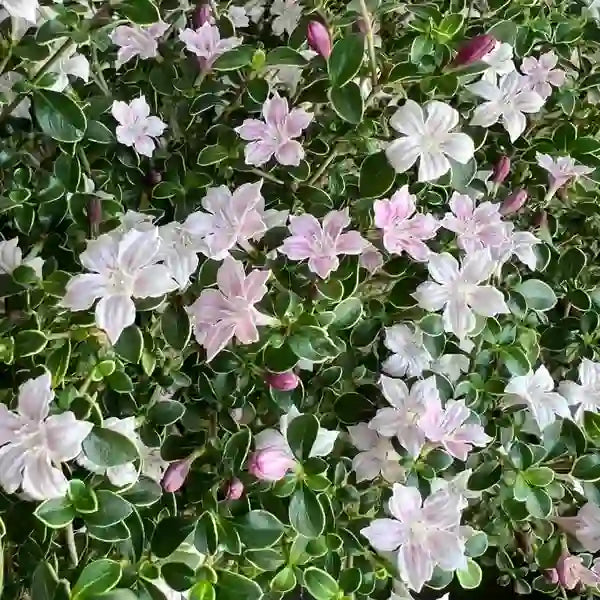
Serissa foetida variegated,Serissa Variegated, Snow Rose
Selling Size : Single Plant |2.5'' Pot Included | Secure Packing
The Variegated Serissa, also known as Snow Rose or Tree of a Thousand Stars, is a captivating plant, often grown as a bonsai. While its delicate white flowers and small variegated leaves make it a stunning addition to any collection, it is known for being a bit "fussy" and sensitive to its environment. The key to success is providing a stable and consistent care routine.
Here's a comprehensive guide to caring for your Variegated Serissa:
Light
Bright, Indirect Light is Essential: Your Serissa needs plenty of light to thrive, maintain its variegation, and produce flowers. A location near a south- or east-facing window is ideal.
Avoid Direct Afternoon Sun: While it loves bright light, intense, direct afternoon sun can scorch the leaves, especially if the plant is not acclimated to it.
Outdoor Care: In warm weather (when temperatures are consistently above 50-55°F or 10-13°C), the plant will benefit from being outdoors in a sunny spot. Just be sure to protect it from harsh winds and bring it inside before the temperatures drop.
Consistency is Crucial: The Serissa is very sensitive to changes in its environment. Once you find a spot where it's happy, it's best to leave it there. Moving it around can cause it to drop its leaves.
Watering
Keep the Soil Consistently Moist: The biggest challenge with Serissa is finding the right balance with watering. It dislikes both being too wet and too dry. Allowing the soil to dry out completely will lead to leaf drop, while consistently soggy soil can cause root rot.
Check the Soil Regularly: A good practice is to check the top inch of the soil. If it feels dry, it's time to water thoroughly. Water until it drains from the bottom of the pot.
Humidity: Serissa thrives in high humidity.
Use a humidity tray (a shallow tray filled with pebbles and water) to increase moisture around the plant.
Regular misting can help, but avoid misting the flowers as this can cause them to rot.
Avoid placing the plant near drafts or air vents, which can dry out the foliage.
Soil and Fertilizing
Use Well-Draining Soil: A well-draining potting mix is crucial to prevent the roots from becoming waterlogged. For bonsai, a mix specifically designed for bonsai trees or an aroid mix with good aeration is ideal.
Fertilize During the Growing Season: During the spring and summer, when the plant is actively growing and flowering, feed it every 2-4 weeks with a balanced liquid fertilizer diluted to half strength.
Do Not Fertilize a Stressed Plant: If your Serissa is struggling, has just been repotted, or is not actively growing, do not fertilize it. This can burn the roots and make the problem worse.
Pruning and Repotting
Pruning: Serissa responds well to pruning. You can prune back new shoots to maintain the desired shape. This also encourages the plant to produce new growth and flowers. The best time for major pruning is in early spring before new growth begins, but light pruning can be done throughout the growing season.
Repotting: Young plants typically need to be repotted every 1-2 years, while older ones can be repotted less frequently (every 3-4 years). Repot in the early spring. When you repot, you can moderately prune the roots to keep the plant healthy.
Common Problems
Leaf Drop: This is the most frequent and frustrating issue with Serissa. It is almost always a reaction to a change in the plant's environment. Common causes include:
Over- or under-watering.
A sudden change in light or temperature.
Moving the plant to a new location.
Inappropriate soil or nutrient issues.
Foul Odor: The species name "foetida" comes from the slightly unpleasant odor the leaves and roots can give off when bruised or cut. This is a normal characteristic of the plant and not a sign of a problem.
Pests: Keep an eye out for common pests like spider mites, scale, and aphids.
With careful attention to its needs for consistent light, water, and a stable environment, your Variegated Serissa can be a beautiful and long-lasting plant.

